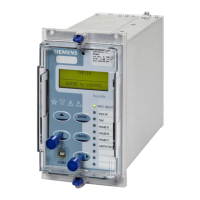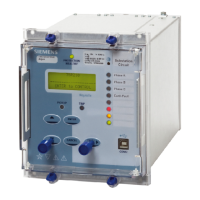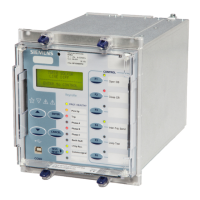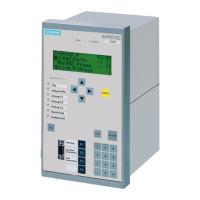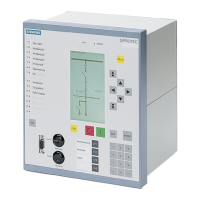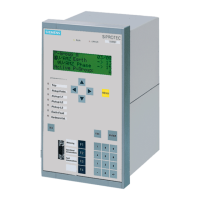7SG12 DAD N Applications Guide
Small enough so that dangerous over-voltages do not occur.
C x I
MaxSecIntFault
β
< 3kV
The Metrosil must be rated sufficiently to dissipate the heat created by the flow of maximum secondary
internal fault current:
Required Continuous Rating of Metrosil (W) ≥ (4 / π) x I
MaxSecIntFault
x V
K
This will usually give a massive power rating requiring a Metrosil of unrealistic size. For this reason the
Metrosil is chosen so that it can withstand I
MaxSecIntFault
for only the maximum fault clearance time.
Generally using the Metrosil’s one second rating is sufficient.
3.3 Fault Setting
To achieve correct sensitivity to in-zone faults, the protection scheme must typically operate for a primary
current of 10-30% of the minimum primary fault current, I
MaxPriIntFault
.
I
MinPriIntFault
is a complex figure which must be calculated from a detailed system study.
In addition, allowance must be made for the magnetising current of the paralleled CTs. In effect, these act
as losses in the secondary circuit and so reduce the secondary current available to operate the protection.
Primary Operate Current = [(Number of CTs x Magnetising Current at I
s
) + I
s
] x CT Ratio
This assumes there is little or no current leakage through the Metrosil or any other current paths.
If this is greater than the maximum allowable Primary operate current of I
MinPriIntFault
x 30%, then I
s
must be
reduced to bring it back within specification. This, of course, would entail re-calculating the value of R
stab
.
The process is thus iterative until a suitable primary operate level is achieved.
As the number of paralleled CTs increases, the losses through magnetising current become so large that it
becomes impossible to set I
s
low enough. At this point the scheme becomes unworkable. As a very rough
guideline, the maximum number of paralleled CTs is about 20.
Similarly, if the Primary Operate Current is smaller than the minimum allowable Primary operate current of
I
MaxPriIntFault
x 10%, then I
s
must be increased to bring it back within specification.
If it is not possible to increase I
s
then a Shunt Resistor, R
shunt,
can be placed in parallel with the relay. This
has the effect of modifying the above equation to:
Primary Operate Current = [(Number of CTs x Magnetising Current at I
s
) + I
s
+ I
shunt
] x CT Ratio
Relay
R
stab
R
Shunt
Figure 7 – Shunt Resistor
The value of R
shunt
can then be calculated:
I
shunt
≥ (Primary Operate Current / CT Ratio) -[(Number of CTs x Magnetising Current at I
s
) + I
s
]
R
shunt
≤ (I
s
x R
stab
) / I
shunt
For solidly earthed systems, where the fault current will be very high, it is acceptable practice to use a
primary fault setting of 50% of the Busbar full load current.
3.4 Check Zone
On double busbar systems, where there will be a significant number of switching operations, it is usual to
provide an extra level of tripping security by fitting a Check Zone relay. This monitors the current of every
incomer and outgoing feeder on the Busbar, but not the internal Busbar Sections and Couplers.
©2010 Siemens Protection Devices Limited Chapter 5 Page 7 of 16

